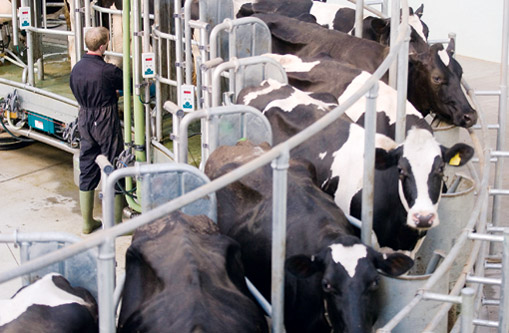Keeping on top of milk hygiene

Improving milk hygiene can yield significant benefits, both in financial and welfare terms. Olivia Cooper finds out how it’s done
Many milk contracts reward producers for high standards of hygiene, but eliminating mastitis altogether is unrealistic. So what can farmers really do to improve milk hygiene?
The key, according to Tim McKendrick, dairy husbandry consultant at The Dairy Group, is cleanliness of the cows. “Cows which are dirty have a much higher risk of contamination, even if you clean their teats really well in the parlour.”
Farmers should focus on keeping gateways, tracks, cubicles and collecting areas as clean as possible, scraping passages at least twice a day when housed. “Clipping tails and flanks reduces soiling around the udder – and udder singeing can really help as well.” Producers should use a purpose-made, low-heat flame every two months. “It definitely makes it easier to prepare and clean the teats.”
Rigorous parlour routines are also important, says Mr McKendrick. “You need to pre-dip or spray and use an individual wipe for each cow. Post-dipping or spraying will reduce the risk of spreading mastitis – and dipping gives better coverage than spraying; it really is the gold standard.”
When washing down the parlour, producers should ensure water is 85°C to start with, circulating at 65°C with the correct amount of chemical. “The final temperature should be no less than 50°C.” Bulk tanks should be checked to make sure they are working efficiently, as warm milk is more prone to bacterial growth, he adds.
Mary Cook, who milks 200 cows at Smokey Farm, Staplegrove, Somerset, won Milk Link’s prestigious milk hygiene award this year, achieving a rolling bactoscan of 10.8 and somatic cell count of just 64.5 cells/ml. “I’m very proud of my team, because they put a lot of effort into cow health and hygiene,” she says.
The Holstein/Friesian cows are crossbred for greater vigour. Calving year-round, they are housed over the winter and average 8,800 litres at about 4.2% butterfat and 3.5% protein.
“We’ve just converted all our cubicles from straw and mattresses to sand – before, we only had sand for the dry cows, which we kept in for the whole dry period. We started doing that about four years ago, and it dramatically reduced the number of mastitis cases in freshly-calved cows.”
Mrs Cook has a herdsman, two assistants and a tractor driver, all of whom can switch jobs according to demand. “We take out any dirty sand twice a day and bed up every five days – and we are very particular about keeping collecting areas and passages clean.”
Achieving high hygiene milk is all about attention to detail, she says. “I like to think that all our cows are in very good health. Lame cows are more likely to get mastitis, so we pay attention to their feet and general health. We also clip their tails and try to keep them as clean as possible.”
She rotates paddocks to keep them clean, mixes the heifers with the dry cows and trains them to cubicles before they calve, to reduce stress as they come into milk. “If they’re not stressed, they are less likely to get any health problems.”
The cows are milked twice a day, pre-dipped and wiped, and sprayed with an iodine-based spray after milking. “All the sick cows are marked with a red spray and milked with a dump unit. We treat any cow that has the slightest chance of having mastitis, and if there’s any suspicion with a swollen quarter she’ll be tested with a California Milk Test.” The parlour also has in-line mastitis detectors and monthly milk records help track individual cell counts.
“We probably have 18-20 cases of mastitis for every 100 cows, and sometimes cell counts rise in late lactation, so we may dry those cows off.” Cows with persistently high cell counts may be dried off in the offending quarter and milked until a feasible time to be culled. “Where cows have had mastitis in the past two months, we will treat the unit with an acid wash after milking and we are considering buying a cluster flushing system.”
Achieving such high milk quality has considerable benefits, says Mrs Cook. “We get an extra 0.5p/litre for bactoscan and 0.5p/litre for cell count. We’re producing 1.75m litres a year, so that makes a big difference. There are also the benefits in cow health – we have a lower culling rate and our vet bills are less. We get mastitis like anyone else, it’s just about how you manage it and trying to prevent rather than cure.”
Top tips for milk cleanliness:
• When washing down the parlour, ensure water is 85°C to start, circulating at 65°C with the correct amount of chemical.
• Keep gateways, tracks, cubicles and collecting areas as clean as possible.
• Clip tails and flanks and udder singe to help reduce soiling around the udder.
• Pre-dip or spray and use an individual wipe for each cow.
• Regularly clean bedding (including sand).
• Maintain cow health.
